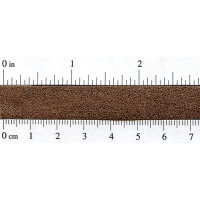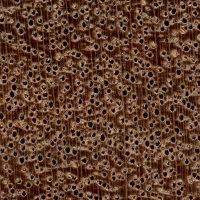 |
Common Name(s): Keruing, Apitong Scientific Name: Dipterocarpus spp. Distribution: Southeast Asia Tree Size: 100-200 ft (30-60 m) tall, 3-5 ft (1-1.5 m) trunk diameter Average Dried Weight: 46 lbs/ft3 (745 kg/m3) Specific Gravity (Basic, 12% MC): .59, .74 Janka Hardness: 1,390 lbf (6,170 N) Modulus of Rupture: 16,710 lbf/in2 (115.2 MPa) Elastic Modulus: 2,293,000 lbf/in2 (15.81 GPa) Crushing Strength: 8,900 lbf/in2 (61.4 MPa) Shrinkage: Radial: 5.5%, Tangential: 10.8%, Volumetric: 16.3%, T/R Ratio: 2.0 |
Color/Appearance: Heartwood ranges from a light to medium yellowish brown to a darker reddish brown. Overall appearance and grain patterning is rather homogenous and bland.
Grain/Texture: Grain is generally straight to slightly interlocked. With a medium to coarse texture and moderate natural luster.
Endgrain: Diffuse-porous; exclusively solitary; very large pores in no specific arrangement, very few; parenchyma diffuse-in-aggregates, vasicentric; medium to wide rays, spacing normal.
Rot Resistance: Varies depending on species, though generally reported as moderately durable; moderate to poor insect resistance.
Workability: Generally easy to work with hand or machine tools, though silica present in the wood tends to dull cutters. Also, resin can exude from the wood and build up on tools and also make wood finishing difficult. Movement in service is fairly large.
Odor: Has a distinct resinous scent when being worked.
Allergies/Toxicity: Although severe reactions are quite uncommon, Keruing has been reported to cause skin irritation. See the articles Wood Allergies and Toxicity and Wood Dust Safety for more information.
Pricing/Availability: Not commonly imported to North America, Keruing is sometimes available as lumber or flooring planks. Prices should be moderate for an imported lumber.
Sustainability: This wood species is not listed in the CITES Appendices, but many species of Dipterocarpus are on the IUCN Red List. They are listed as critically endangered due to a population reduction of over 80% in the past three generations, caused by a decline in its natural range, and exploitation.
Common Uses: Furniture, flooring, trailer decks, and utility lumber.
Comments: Keuiring is made up of numerous closely related species in the Dipterocarpus genus (most of which are now critically endangered), and a good amount of variability in color, weight, and working properties is normal. The wood is also sold under the name Apitong, or less frequently under the somewhat wishful name of Asian Mahogany. Keruing is much less dimensionally stable than genuine mahogany.
None available.
 |
 |
 |

|





I am working with some Apitong to make an outdoor table. The wood is dry at 8~9%. I have noticed the sap pours out of the end grain after cutting it. It joints and planes nicely. It is heavier than oak I have in the same sizes.
Hi there, I am very interested to hear about your experience with apitong, / keruing. I wonder how well it glues together. I am wondering if I can use it to glue / cold molded strip planking ?? If expoxy holds the strips together strong enough or if the resin that comes out makes the clue not stick ??
It doesn’t glue well together at all, generally.
The material is difficult to machine, paint, and bond because of how resinous it is.
It’s great for truck and container beds.
I have some wood that I am using for the body of a bass guitar project. It looks to me like one of the meranti types but it exudes a very sticky resin when it gets warm either through use of power tools or simply left in the moderate sun of an English “summer”. I wonder if it could be keruing (Dipterocarpus) species?
Any views on the best way to seal the end grain to prevent the resin damaging the clear laquer finish would be appreciated.